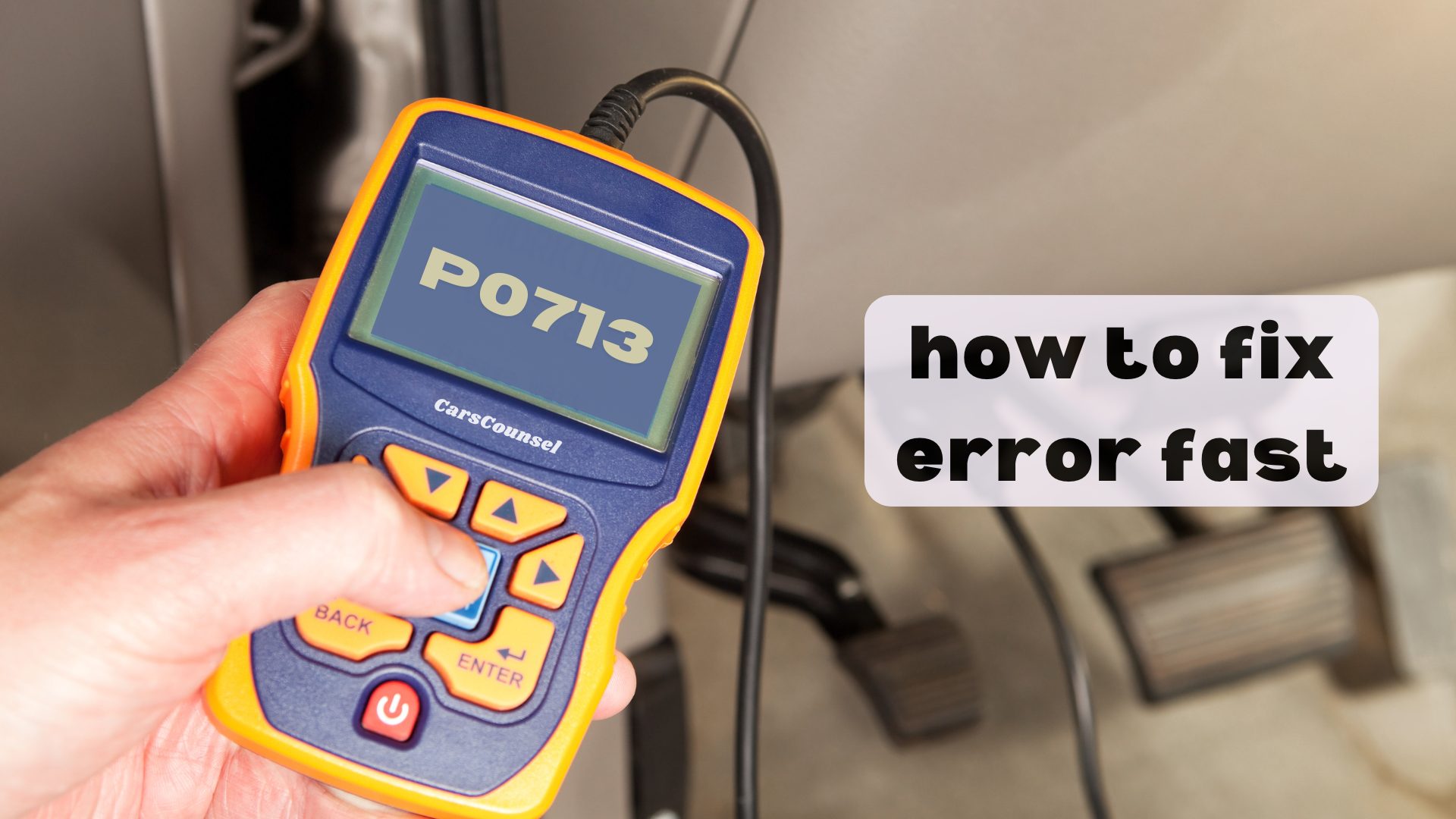When you’re dealing with the P0713 code, start by checking the transmission fluid temperature sensor and its wiring for any damage or corrosion.
This error can cause noticeable issues like erratic shifting or transmission overheating, but don’t worry—fixing it might be simpler than you think.
Using an OBD-II scan tool and a multimeter, you can quickly find the OBD2 problem. Understanding why these steps are important and what they involve can make the difference between a quick fix and a long-term solution.
So, what exactly should you look out for next?

Quick Navigation
Key Takeaways
- Check and secure all wiring connections to the transmission fluid temperature sensor.
- Use a code reader to find and clear the P0713 error code.
- Replace the bad transmission fluid temperature sensor if it’s damaged.
- Make sure the transmission fluid is clean and at the right level.
Understanding the P0713 Code
The P0713 code means there’s an issue with your vehicle’s transmission fluid temperature sensor. This sensor keeps track of the fluid’s temperature to ensure the transmission works properly. If the sensor isn’t working right, it can mess with the car’s ability to manage the transmission, leading to potential problems.
To avoid these issues, make sure to regularly maintain your transmission. Check the sensor’s wiring and connections for any damage or wear.
Dirty transmission fluid can also cause problems, so change the fluid regularly. By keeping up with maintenance, you can prevent expensive repairs and keep your transmission running smoothly.
Common Symptoms of P0713
If your car is having trouble with erratic gear shifting or overheating, it could be showing signs of a P0713 code. One of the main symptoms is sudden and unexplained overheating of the transmission, which can cause serious damage if not fixed quickly.
You might also notice your car shifting gears unpredictably or roughly, making driving less smooth and more stressful. Another sign is the Check Engine Light coming on, indicating there might be a problem.
These issues happen because the transmission fluid temperature sensor isn’t giving accurate information to the powertrain control module. Spotting these signs early can help you fix the problem before it leads to major transmission damage.
Causes of P0713 Errors
Understanding why P0713 errors happen can help you fix the problem before it leads to bigger transmission issues.
The most common cause is a bad transmission fluid temperature sensor, which can mess up how the sensor reads temperatures.
Problems with the wiring or connections to the sensor can also cause this error code.
Sometimes, the transmission control module (TCM) might be the issue.
Dirty transmission fluid, often missed during routine maintenance, can also affect sensor readings.
Lastly, an overheating transmission can cause the sensor to fail.
By knowing these potential causes, you can take steps to keep your transmission in good shape and avoid expensive repairs.
Regularly check and service your vehicle to keep these problems under control.
Diagnostic Tools Required
You’ll need a scan tool to properly read and diagnose the P0713 code from the PCM. This important device helps you access trouble codes and real-time data. Make sure your scan tool works with your car’s make and model. Here’s a handy table of key diagnostic tools:
| Diagnostic Tool | Purpose |
|---|---|
| OBD-II Scan Tool | Read diagnostic trouble codes |
| Multimeter | Check sensor circuits |
| Infrared Thermometer | Measure transmission fluid temp |
| Wiring Diagram | Follow electrical connections |
| Service Manual | Detailed repair instructions |
Using the right tools ensures accurate diagnostics, saves time, and avoids more damage. Always follow the manufacturer’s instructions for each tool to get accurate readings and effective results.
Inspecting the Sensor
Checking the Sensor
To check the sensor, first, disconnect the vehicle’s battery for safety. Next, find the transmission fluid temperature sensor, which is usually on the transmission itself. Look at it closely for any damage or wear.
- Check connections: Make sure all wires and connectors are secure and not corroded.
- Look for fluid leaks: Fluid can mess up the sensor if it gets inside.
- Inspect the sensor body: Look for cracks or other damage that could affect how it works.
Keeping the sensor working properly and the wiring intact is crucial. A damaged sensor can give wrong readings, which can mess up how the transmission works.
Testing Sensor Circuit
Begin by using a multimeter to check the voltage and resistance in the sensor circuit to make sure it’s working right.
Make sure your multimeter is set correctly for measuring voltage and resistance.
First, compare the sensor readings to what the manufacturer says they should be. If the readings don’t match, the sensor might be faulty.
Next, check the wiring for any breaks or shorts by testing for continuity. Disconnect the sensor and measure the resistance across its terminals; it should be within the expected range.
If either test doesn’t pass, you might need to replace the sensor or fix the wiring to resolve the P0713 error code.
Evaluating the TCM
Check the Transmission Control Module (TCM) to make sure it’s working right. This helps ensure your transmission runs smoothly and helps spot any problems early.
- Check for Extra Codes: Use an OBD-II scanner to see if there are any other trouble codes.
- Look at TCM Connectors: Check the TCM connectors for any rust or damaged pins.
- Test TCM Response: Use a multimeter to check the TCM’s electrical responses.
A working TCM ensures your transmission performs well and avoids bigger issues.
Accurate checks and replacing a bad TCM in time can save you from costly repairs later on.
Checking Transmission Fluid
After checking the transmission control module (TCM), it’s important to look at the transmission fluid to make sure it’s at the right level and clean.
First, find the transmission dipstick and make sure your car is on a flat surface. Pull out the dipstick, wipe it clean, put it back in, and then check the fluid level. The fluid should reach the ‘Full’ mark.
Next, take a look at the fluid itself; it should be a clear, reddish color without any burnt smell or particles. If the fluid looks dirty or burnt, it’s time to change it.
Regularly checking and changing your transmission fluid helps prevent problems and keeps your transmission running smoothly.
Replacing the Temperature Sensor
Replacing the transmission fluid temperature sensor is a straightforward task if you follow these steps:
- Safety First: Disconnect the car battery to avoid any electrical issues while you work.
- Check Compatibility: Make sure the new sensor matches your vehicle model.
- Remove the Old Sensor: Find the sensor, usually located on the transmission pan, and carefully unplug it.
- Install the New Sensor: Put the new sensor in place and secure it tightly.
- Reconnect the Wiring: Attach the wiring harness to the new sensor and ensure all connections are firm.
- Test Everything: Reconnect the battery, start the car, and check to ensure everything is working correctly and there are no error codes.
Following these steps will help you replace the sensor smoothly and get your vehicle back to normal.
Preventing Future Errors
To avoid future issues like the P0713 and P0731 codes, keep up with regular maintenance and drive carefully.
Start by checking and changing your transmission fluid regularly. Clean fluid helps sensors work well and prevents dirt buildup. Also, check your transmission fluid temperature sensor for wear and replace it if needed. Watch out for any wiring problems that could affect the sensors.
Drive gently to avoid putting too much stress and heat on your transmission. Regular diagnostic checks can catch problems early and save you money on repairs.
More OBD-II Codes
Frequently Asked Questions
Can Driving With a P0713 Code Damage My Transmission?
Yes, driving with a P0713 code can harm your transmission. Ignoring it can make transmission problems and fluid issues worse. Fix it quickly to prevent overheating and serious damage, and to keep your transmission working well for a long time.
How Long Does It Take to Fix a P0713 Code?
Using diagnostic tools, you can check the transmission sensors and wiring. The repair typically takes 1-2 hours, depending on your skill level and how serious the problem is. Make sure to do a thorough inspection to prevent any future issues.
What Is the Average Cost to Repair a P0713 Error?
Fixing a P0713 error will usually cost you between $150 and $400. This price includes the cost of diagnosing the problem, buying parts, and paying for labor. Be sure to check the wiring and sensors to prevent having to spend more money on this issue down the road.
Can I Reset the P0713 Code Without Fixing the Problem?
Can you reset the P0713 code without fixing the problem? Yes, you can, but it’s not a good idea. You can use diagnostic tools to clear the code, but ignoring the issue can lead to bigger problems and end up costing more in repairs.
Will a P0713 Code Affect My Vehicle’s Fuel Efficiency?
Yes, a P0713 code can affect your car’s fuel efficiency. Symptoms like erratic shifting and transmission overheating make the engine work harder, which lowers fuel efficiency. Fix the issue quickly to prevent more damage.
Conclusion
You’ve dealt with the P0713 code! By looking over your transmission fluid temperature sensor, checking the wiring, and using your OBD-II scan tool and multimeter, you’ve tackled the problem directly.
If needed, replace the sensor and make sure your transmission fluid is clean—it’s essential for your vehicle.
Regular checks will help you avoid future issues. Stay on top of it, and your car will run better than ever!

